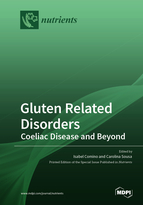Gluten Related Disorders: Coeliac Disease and Beyond
A special issue of Nutrients (ISSN 2072-6643). This special issue belongs to the section "Nutritional Epidemiology".
Deadline for manuscript submissions: closed (31 March 2021) | Viewed by 42786
Special Issue Editors
Interests: coeliac disease; gluten-related disorders; gluten immunogenic peptides and proteins; proteomics; gluten food analysis; immunology; food allergy and intolerance
Interests: coeliac disease; gluten-related disorders; gluten immunogenic peptides and proteins; proteomics; gluten food analysis; immunology; food allergy and intolerance.
Special Issue Information
Dear Colleagues,
Gluten-related disorders (GRDs) have emerged as an epidemiologically relevant phenomenon with an estimated global prevalence of close to 5%. Different mechanisms are involved in the pathogenesis of GRDs. Although they are characterized by peculiar pathogenetic pathways involved in their development, they share similar clinical manifestations making their differential diagnosis challenging.
Among the gluten-related disorders, coeliac disease (CD) is the best known to date. It is characterized by a heterogeneous clinical presentation, affecting any organ or tissue with gastrointestinal, extraintestinal manifestations, subclinical, seronegative, or non-responsive, among others. However, CD research is changing rapidly due to a steady increase in knowledge tackling its pathophysiology, diagnosis, follow-up, and therapeutic options. Indeed, novel findings provide a deeper insight not only of CD, but also of other GRDs: wheat allergy, non-coeliac gluten sensitivity, dermatitis herpetiformis, and gluten ataxia. In this Special Issue, we aim to broaden our knowledge of all essential aspects of GRDs. Potential topics include the following:
- Novel findings providing a deeper insight into the pathogenic mechanisms underlying GRDs.
- Effect of the gluten-free diet (GFD) on GRDs, including patient management after diet instauration, adherence to the diet, and/or ways to monitor it.
- Potential therapeutic strategies based on the immunopathogenesis of these disorders.
- Clinical and pathogenic follow-up of patients with GRDs.
- New knowledge about GFD: technological and nutritional aspects.
Dr. Isabel Comino
Dr. Carolina Sousa
Guest Editors
Manuscript Submission Information
Manuscripts should be submitted online at www.mdpi.com by registering and logging in to this website. Once you are registered, click here to go to the submission form. Manuscripts can be submitted until the deadline. All submissions that pass pre-check are peer-reviewed. Accepted papers will be published continuously in the journal (as soon as accepted) and will be listed together on the special issue website. Research articles, review articles as well as short communications are invited. For planned papers, a title and short abstract (about 100 words) can be sent to the Editorial Office for announcement on this website.
Submitted manuscripts should not have been published previously, nor be under consideration for publication elsewhere (except conference proceedings papers). All manuscripts are thoroughly refereed through a single-blind peer-review process. A guide for authors and other relevant information for submission of manuscripts is available on the Instructions for Authors page. Nutrients is an international peer-reviewed open access semimonthly journal published by MDPI.
Please visit the Instructions for Authors page before submitting a manuscript. The Article Processing Charge (APC) for publication in this open access journal is 2900 CHF (Swiss Francs). Submitted papers should be well formatted and use good English. Authors may use MDPI's English editing service prior to publication or during author revisions.
Keywords
- Gluten-related disorders
- Coeliac disease
- Gluten-free diet
- Immunopathogenesis
- Allergy
- Intolerance
- Clinical manifestations







